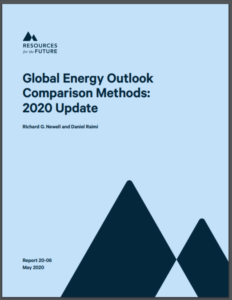Full Title: Global Energy Outlook Comparison Methods: 2020 Update
Author(s): Richard Newell and Daniel Raimi
Publisher(s): Resources for the Future (RFF)
Publication Date: May 20, 2020
Full Text: Download Resource
Description (excerpt):
We update a harmonization methodology previously developed in 2015 to facilitate comparisons of long-term global energy projections issued by Bloomberg New Energy Finance (BNEF), BP, Equinor, ExxonMobil, the International Energy Agency (IEA), the Institute for Energy and Economics (Japan), the Organization of the Petroleum Exporting Countries, Shell, and the US Energy Information Administration. Decisionmakers in the public and private sector rely on these projections to inform investments and policy, but comparing these outlooks on an apples-to-apples basis is not possible due to a variety of methodological differences. For example, the US EIA and BP’s exclude non-marketed traditional biomass, resulting in estimates of global primary energy consumption that are 8 to 10 percent lower than other projections. Assumptions about energy content of fossil fuels can vary by more than 11 percent in the data examined here, requiring significant adjustment of primary energy consumption estimates. Conventions about primary energy conversion of renewables can also alter estimates by as much as a 65 percent decrease to a 3.8-fold increase for particular electricity sources, relative to IEA estimates. We also find that there are significant differences in historical data used in these outlooks, even when measured in fuel-specific physical units such as barrels, cubic meters, or tonnes. After taking into account these differences, our harmonization methodology brings estimates within 3.3 percent or less of one another for most fuels in the benchmark years of 2017 and 2018. In this document, we describe the process by which we enhance the comparability of outlooks by adjusting for differences in assumptions such as fuel classifications, energy content assumptions, conversion efficiencies, and more. We present a selection of the harmonized results, benchmarked to the IEA’s 2019 World Energy Outlook.
